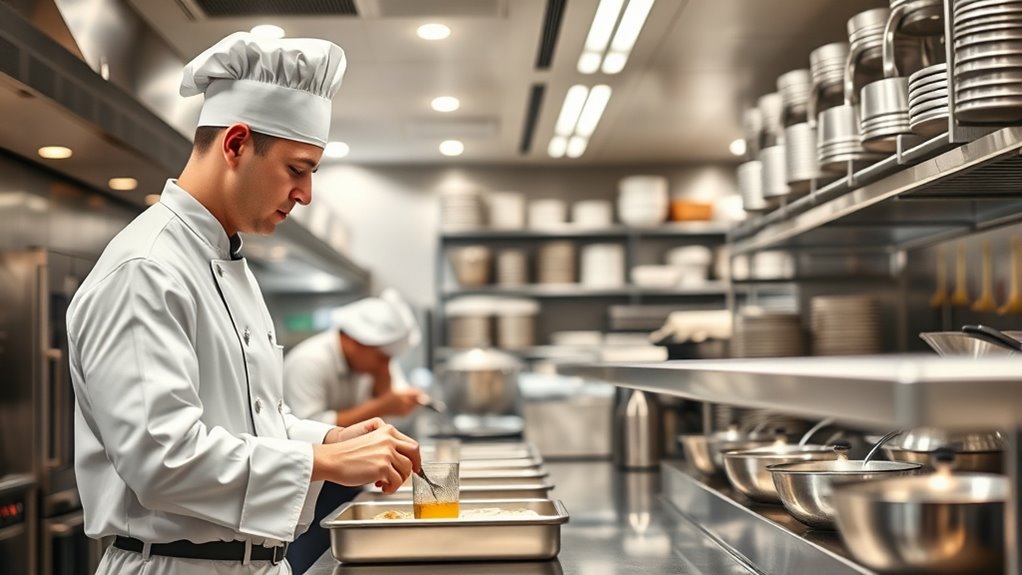BOH labor percentage measures how efficiently your restaurant manages back-of-house labor costs compared to total sales. It’s calculated by dividing your BOH labor costs by sales and multiplying by 100 to get a percentage. A lower percentage indicates better efficiency. Factors like staff productivity, scheduling, and inventory practices influence this metric. Keeping it in check can help control costs and improve overall operations—stay with us to learn how to optimize your restaurant’s performance.
Key Takeaways
- BOH Labor Percentage measures back-of-house labor costs as a portion of total sales.
- It is calculated by dividing BOH labor costs by total sales and multiplying by 100.
- A lower percentage indicates higher efficiency and better resource management.
- Factors influencing this metric include staffing, workflow, inventory, and training.
- Monitoring helps control costs, improve productivity, and optimize restaurant operations.

Have you ever wondered how much of your restaurant’s budget goes toward back-of-house (BOH) labor? Understanding BOH labor percentage helps you see how efficiently your kitchen and support staff are operating. It’s a key metric that reveals how much you’re spending on employees relative to your total sales. This percentage isn’t just about payroll—it’s about how well you’re managing your resources to maximize profitability. When you keep a close eye on this figure, you can identify areas where you might be overspending or underperforming, giving you a clearer path to optimizing your operations.
Understanding your restaurant’s BOH labor percentage reveals how efficiently your kitchen operates and helps optimize profitability.
The BOH labor percentage is calculated by dividing your back-of-house labor costs by your total sales, then multiplying by 100 to get a percentage. For example, if your BOH labor costs are $20,000 and your sales are $100,000, your BOH labor percentage is 20%. This number varies depending on your restaurant’s size, concept, and location, but generally, a lower percentage indicates better efficiency. To improve this metric, focus on inventory management—keeping track of stock levels, reducing waste, and ordering just what you need. When inventory is well-managed, your kitchen runs smoothly, and your staff can work more productively, directly impacting your labor costs. Additionally, understanding projector technology can help create an environment that enhances staff training and presentation of menu items, indirectly supporting operational efficiency.
Employee productivity plays a vital role here. When your team works efficiently, you’re getting more output for less input. Training, clear procedures, and proper staffing levels all contribute to higher productivity. By monitoring performance and providing ongoing coaching, you ensure your team isn’t just busy but effective. When employees are productive, they complete tasks faster and with fewer errors, which means you can keep your BOH labor costs in check without sacrificing quality or service.
Keeping an eye on your BOH labor percentage also helps you spot issues before they become costly. If the percentage starts creeping up, it might signal overstaffing, inefficient workflows, or inventory mismanagement. In such cases, you can re-evaluate schedules, streamline processes, or refine your inventory practices. The goal is to find the right balance—having enough staff to deliver great food without inflating labor costs unnecessarily. This balance ensures your restaurant remains profitable while maintaining high standards.
In essence, understanding and managing your BOH labor percentage empowers you to control costs, improve employee productivity, and optimize inventory management. When you take a proactive approach, you’ll better understand where your money is going and how to make smarter decisions that lead to a healthier bottom line.
Frequently Asked Questions
How Does BOH Labor Percentage Vary Across Different Restaurant Types?
Your BOH labor percentage varies across restaurant types because staff scheduling and labor efficiency differ. In quick-service spots, it’s usually lower due to streamlined operations, while full-service restaurants tend to have higher percentages because of more complex tasks and longer shifts. You can optimize this by adjusting staff scheduling based on busy hours, which improves labor efficiency and keeps your BOH labor costs in check regardless of the restaurant style.
What Factors Influence Fluctuations in BOH Labor Percentage?
Fluctuations in BOH labor percentage are influenced by factors like employee productivity and wage standards. When your staff works efficiently, you can reduce labor costs without sacrificing service quality. Conversely, higher wage standards increase expenses, impacting the percentage. Changes in menu complexity or seasonal demand also play roles, requiring you to adjust staffing levels. Monitoring these factors helps you optimize labor costs while maintaining operational effectiveness.
How Can Restaurants Reduce Their BOH Labor Costs Effectively?
You can reduce your BOH labor costs by optimizing staff scheduling, ensuring you’re only scheduling the right number of employees for busy periods. Incorporate technology integration, like labor management software, to track productivity and forecast staffing needs accurately. Regularly review your schedules and adjust based on actual sales trends, avoiding overstaffing. Training your team efficiently also helps improve productivity, ultimately lowering labor costs without sacrificing service quality.
What Is the Ideal BOH Labor Percentage Benchmark?
You’re aiming for an ideal BOH labor percentage benchmark around 25-30%, but it varies with your restaurant’s size and concept. To hit this mark, focus on staff scheduling and wage optimization, ensuring you’re not overstaffed during slow periods or understaffed during busy times. Remember, a tight ship runs smoothly when you balance labor costs with service quality, so keep a close eye on these metrics to stay on course.
How Does BOH Labor Percentage Impact Overall Profitability?
Your BOH labor percentage directly impacts your overall profitability by influencing labor costs and staffing efficiency. If the percentage is too high, you spend too much on labor, reducing profit margins. Conversely, if it’s too low, staffing might be insufficient, affecting service quality and customer satisfaction. Monitoring and optimizing this metric helps you control labor costs effectively, ensuring your operations stay profitable while maintaining efficient staffing levels.
Conclusion
Understanding your BOH labor percentage helps you manage costs effectively, but don’t forget, it’s not just about numbers. While it reflects efficiency behind the scenes, it also reveals the human effort fueling your business. Balancing these figures with your team’s well-being creates harmony between profit and passion. So, as you monitor your metrics, remember that behind every percentage is a team working hard—reminding you that numbers are just one part of a bigger story.









